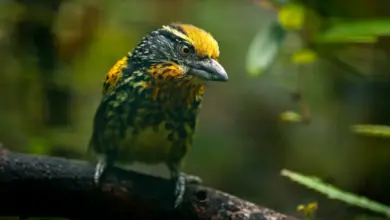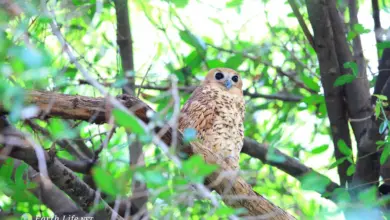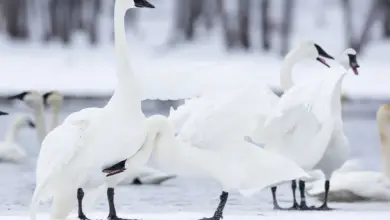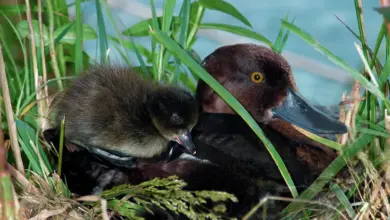The Canada Geese (Branta canadensis) – also sometimes referred to as Canadian Geese – are the most widely distributed geese in North America, with a range that stretches across the Arctic and temperate regions of North America.
They also occur in northern Europe, on the Kamchatka Peninsula in eastern Siberia, eastern China and throughout Japan. Introduced populations have also established themselves in New Zealand.
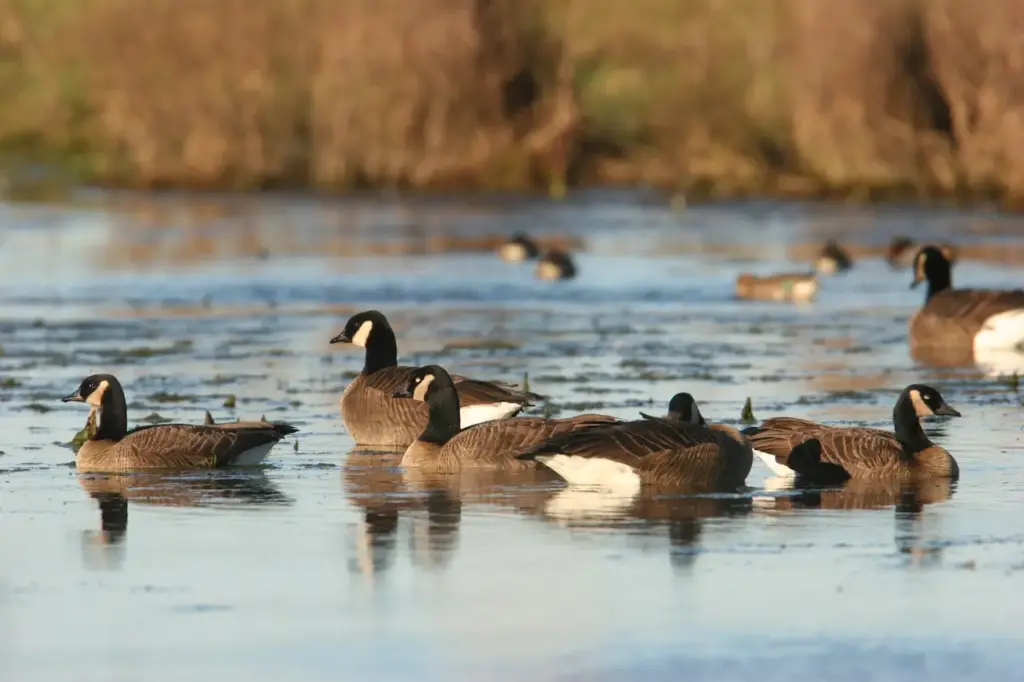
This species has adapted well to living in urban and suburban areas and is commonly found on lakes, ponds and rivers.
This large goose is easily recognized by its black head and neck, distinctive white patches on the face, light tan to cream chest and its otherwise brownish-grey plumage.
They are strong swimmers, divers and flyers. Canada Geese are well known for their V-shaped flight formation, during which the front position is rotated since flying in front consumes the most energy. In Canada and other breeding territories, the loud honking calls made by the large flocks of migrating Canada Geese flying above signal the transitions into spring or autumn.
This species is protected in North America under the Migratory Bird Act of 1918, making it illegal to harm, take, or possess migratory birds, any parts of the bird, their nests or their eggs, except during the hunting season, or by special permit (MacGowan, Loven and Whitford).
Ironically, notwithstanding the “legal protection” of this species, lethal culling/mass slaughter of these birds is being employed – via extended hunting seasons, fatal gassing and poisoning – to control the exploding populations of Canada Geese in urban or densely populated areas.
Animal-loving people treat them as pets feeding them regularly, which resulted in many more young being born and successfully raised than their natural conditions would have otherwise allowed.
Many people consider the exploding populations of Canadian Geese or Canada Geese as nuisances because of their messy droppings. One adult Canada goose can produce 1 to 2 pounds of excrement (guano) per day (Filion, Kidd and Aguirre, 2006). Flocks feeding in fields also cause considerable damage to agricultural crops. Geese can also get aggressive towards humans, particularly when they feel their young are threatened.
The male is referred to as “gander,” the female as “goose,” and the chicks are called goslings. A flock of geese on the ground is known as a gaggle. Geese flying in the typical v-formation are referred to as “wedge” or skein.”
The largest wild goose ever recorded was a male Giant Canada Goose (race B. c. maxima), which weighed 24 pounds (10.9 kg) and had a wingspan of 88 inches (2.24 meters).
Alternate (Global) Names
Asturian: Gansu Canadiense, Gansu de Canada … Belarusian: ????????? ??????? … Basque:branta kanadarra … Bulgarian: ???????? ????? … Breton: Ar garreli-Kanada … Catalan: oca del Canadá … Chinese: ????, ????? … Czech: Berneška velká … Danish: Atlantisk Canadagås, Canadagås, Kanadagås … Dutch: Canadese gans, Grote Canadese Gans … Finnish: Kanadanhanhi … French: Bernache du Canada … German: Atlantische Kanadagans, Kanadagans … Irish: Gé Cheanadach … Hungarian: Kanadai lúd … Icelandic: Kanadagæs … Italian: Oca del Canada, Oca del Canada atlantica … Inuktitut: Nedlenuk, Nookliuk … Japanese: shijuukaragan, Shijuukara-gan … Lithuanian: Kanadine bernikle, Kanadin? bernikl?, Kanadine bernikle … Norwegian: Kanadagås … Polish: bernikla kanadyjska … Portuguese: Ganso do Canadá, Ganso-do-Canadá … Romansh: Auca da Canada … Russian: ??????? ?????????, ????????? ??????? … Slovak: bernikla bielobradá, Bernikla vel’ká, bernikla ve?ká, bernik?a ve?ká, bernikla ve?ká/bielobradá … Slovenian: kanadska gos, leucopareia … Spanish: Barnacla canadiense, Ganso canadiense, Ganso de Canadá … Swedish: Kanadagås … Turkish: Kanada Kaz? … Welsh: G?ydd Canada
Description
The Canada Geese measure between 29.9 – 43.3 inches (76 – 110 cm) in length (including the tail) and have a wingspan of 50–71 inches (127 – 180 cm).
The male is about 10% larger than the female. He usually weighs between 7 – 14 pounds (3.2 – 6.5 kg) and the female weighs 5.5 – 12 pounds (2.5–5.5 kg).
The largest race is the “Branta canadensis maxima” or, in English, called “Giant Canada Goose” (obviously named for its larger size). Adult males typically weigh between 8 – 14 pounds (3.6 – 6.4 kg) and adult females about 7 – 12 pounds (3.2 – 5.4 kg) at maturity.
An exceptionally large male – a Giant Canada Goose – weighed 24 pounds (10.9 kg (24 pounds) making this the largest wild goose ever recorded.
The plumage is mostly greyish-brown, with the exception of the black head and the long black neck, the whitish chest and characteristic white patches on the cheeks that run under its chin like a strap (commonly referred to as “chin straps”).
The large webbed feet and wide, flat bill are black. The bill has lamellae (miniature ridges inside the bills of water-feeding birds or “teeth”) around the outside edges of the bill that are used as a cutting tool.
In flight, their large, dark wings can be seen, and possibly a U-shaped white rump and white under-tail feathers.
Male / Female Identification
Males and females look alike, although females are usually a little smaller than males and have a different honk.
Juveniles
Immature birds have a brownish chin strap and duller head and neck colouration.
Yearly Molt:

During the breeding season (typically late-June to mid July), Canada Geese, undergo a complete simultaneous replacement of all their flight feathers, leaving them unable to fly for about a month – until the new flight feathers have grown in. During this time, they are particularly vulnerable to predation and before this moult, they typically move to a safe area near water with readily available food and an unobstructed view of predators or danger. The new flight feathers grow back in time for their migration back to their wintering territories.
The first ones to undergo this moult are typically non-breeding juveniles, non-nesting adults and adults whose nests have been destroyed (Smith, Craven and Curtis, 1999).
Distribution, Migration and Habitat
Canada Geese have an extensive range in northern temperate, sub-arctic and arctic regions. They are found throughout Canada, Alaska and all the lower 48 U.S. states, as well as northern Mexico.
Nesting occurs from northern Alaska, east to Labrador (Newfoundland) and Greenland, and south to southeastern Canada, California, Utah, and northern Arkansas in the United States.
The migratory populations travel south to Florida, the Gulf Coast, and northern Mexico for the winter.
Many populations occurring in the temperate regions are resident (non-migratory).
Canada Geese are native to:
Americas: Canada, Greenland, United States, Mexico.
Islands: Bahamas, Cayman Islands, Cuba, Haiti, Puerto Rico, Saint Pierre and Miquelon, Turks and Caicos Islands
Asia: Kamchatka Peninsula in eastern Siberia, eastern China, and throughout Japan.
They have been introduced:
Austria, Belgium, Czech Republic, Faroe Islands, Finland, France, Germany, Ireland, Netherlands, New Zealand, Poland, Russian Federation, Ukraine, Great Britain and Scandinavia (Denmark, Norway and Sweden)
Great Britain: These geese were introduced into England about 300 years ago, where it is now the most recognized goose species. It is less common in Scotland and Wales.
They occasionally visit:
Australia, Belarus, Bermuda, Bulgaria; Iceland, Jamaica, Japan, Kiribati, Korea, Latvia, Liechtenstein, Lithuania, Luxembourg, Marshall Islands, Portugal, Russia, Slovakia, Slovenia and Spain.
Sedentary or Migratory Species
Canada geese can either be truly migratory or resident (non-migratory).
Those occurring in temperate/mild climates may choose to remain year-round in their home range, due to adequate winter food supply and a lack of predators. However, even those populations that don’t migrate south for the winter, will move north after the breeding season to a safe area for the yearly moult, which lasts about a month.
Some migratory populations no longer travel as far south in the winter as they used to. These changes in migration are attributed to changes in weather patterns (global warming), changes in farm practices that make waste grain readily available in fall and winter, as well as changing hunting pressure.
Over the last decade, the number of migratory Canada geese has seen a decline, whereas resident populations have seen near exponential growth.
Resident / Sedentary Populations
In North America, many non-migratory populations exist within their normal range and introduced flocks have taken up permanent residency outside their traditional range.
In the United States, Canada Geese have established permanent residence from California to the Great Lakes south to Chesapeake Bay and in Virginia’s James River regions, and in the Triangle area of North Carolina (Raleigh, Durham, Chapel Hill), and nearby Hillsborough.
Large numbers are resident in the parks and golf courses of Scottsdale, Arizona.
Resident Canada Geese spend much of the year in the same general area and fly only far enough to find food or open water (especially in winter when ice has covered their ponds).
Seasonal Migrations
Canada Geese are only partially migratory and will travel only short distances.
In spring, they will migrate northward to their breeding territories and starting September through the beginning of November, they travel back to their wintering ranges.
Canada Geese typically undertake the winter or spring migrations in large flocks (often mixed with Cackling Geese) that may contain over 1,000 birds. Most Canada geese have staging or resting areas where they join up with others. Those that migrate early tend to go through the migration much faster, with shorter rest stops. Those that got started later, typically spend more time at the rest stops.
They typically travel along migration routes that take advantage of available food sources – such as vegetation in an earlier state of growth (their preferred food item).
Habitats
Canada Geese occur at all elevations – from coastal through alpine. They are usually found near lakes, rivers, ponds, bays, estuaries, reservoirs, coastal and freshwater marshes, swamps, or other bodies of water (small or large).
They have also adapted well to living in backyards, city parks and agricultural areas situated near water.
When breeding, they prefer riverine areas for breeding, but will also nest in a variety of wetland habitats, such as marshes, swamps, sloughs, ponds, lakes, rivers.
During winter and migration, Canada Geese are commonly seen in agricultural areas, foraging on crops, such as grain, winter wheat, and pasture grasses.
Behaviour
Canada Geese are highly social creatures and – outside the breeding season – are usually seen in groups.
During the breeding season in particular, male Canada geese can be very aggressive towards intruders or predators, including readily attacking humans that get too close to their nests or young.
They also defend their territories against other (unfamiliar) geese, grabbing each other’s chest with their beaks and landing blows with their wings.
These attacks are typically preceded by them lowering their heads to the ground with the beak open, pumping the head up and down, and making hissing sounds.
When charge against humans,, they usually stand erect, spreading their wings and producing a hissing sound followed by the attack, which usually involves biting and wing flapping.
Breeding / Nesting
Canada Geese reach reproductive maturity when they are about 2 years old; and their first nesting usually occurs during the spring-summer of their third year.
They usually find their mates during the second year of their lives.
Canada Geese tend to choose mates that are similar in size (“assortative mating”) and typically mate for life. However, if one perishes, the other will select a new mate.
Most nesting activities are observed between March and June.
The female alone chooses the nest-site, typically beneath shrubs or small trees, placing the nest on a slightly elevated patch of wetland vegetation or using an elevated artificial nest platform. The nests are typically located in an area with good visibility and within 150 feet (45 meters) of water, such as streams, lakes, ponds and sometimes on beaver lodges. Even though pairs may nest within 10 feet (3 meters) of each other, they tend to prefer areas with low nest concentration. They typically return to the same general nesting site year after year.
The female builds the nest, a shallow bowl with a slight depression in the center. The nest is made of sticks, grasses, reeds and weeds, and lined with down feathers plucked from the female’s chest and soft plant material. The nest is approximately 1.5 feet (0.5 meter) in diameter.
Avianweb visitor Hazel Ryland describes a Canada Goose family in her state (Nevada) that took over an abandoned nest in an old cottonwood tree (originally built by red-tailed hawks over 30 years ago, then used by great horned owls). The nest is 75 feet high and for the past three years the Canada Goose parents have raised their chicks in that nest. Several of them have fallen out of the nest but they survived. They just shook themselves and toddled off to a very small bird bath as no large bodies of water were nearby. Hazel assumes that these geese are nesting that high up to evade the local coyotes.
Both the male and female defend the nest before egg laying and after the eggs have been laid, the male alone defends the nest while the female incubates the eggs. They usually only produce one brood a year, but if a clutch is destroyed, may start on a second.
A clutch can consist of 1 – 15 cream-colored eggs (French and Parkhurst, 2001), although the average is 5 or 6 eggs per nest. Eggs are laid one every one and a half days apart. Only after a clutch is complete will the female commence incubation, which lasts about 25 – 30 days to hatching. While brooding the eggs, the female turns the eggs over often as is necessary for optimum development of the embryo. (Eycleshymer, 1907: New, 1957; Robertson, 1961a; Deeming, 1989). The hatching chicks break out of the shell by using an “egg tooth” – a hard growth on top of their beaks, which diminishes not long after hatching. It may take 8 – 36 hours for them to completely break out of the shell (French and Parkhurst, 2001).
The hatchlings are covered in down and their eyes are open. They are able to walk, swim, dive and feed themselves within 1 – 2 days after hatching. At this point, the goslings are led to feeding areas by their parents.
The parents are seen leading their young in a line – usually with one parent at the front and the other at the back. The parents will protect their young, first warning intruders / predators with a hissing sound and then chasing them away. When the young are 7 – 10 weeks old (depending on the subspecies), the goslings are self-supporting and capable of sustained flight. However, the young usually remain with their parents until after the spring migration – when they return to their birthplace.
Goslings from several family broods may form “gang broods” – and these groups may contain up to 100 goslings.
During the incubation period, the adults lose their flight feathers and can’t until after the chicks hatched.
Calls / Vocalizations
Canada Geese are usually very vocal and are known for their deep “honking” calls (sounding like Ha-Honk) – often made in flight.
They make hissing sounds when threatened.
Lifespan / Mortality and Predation
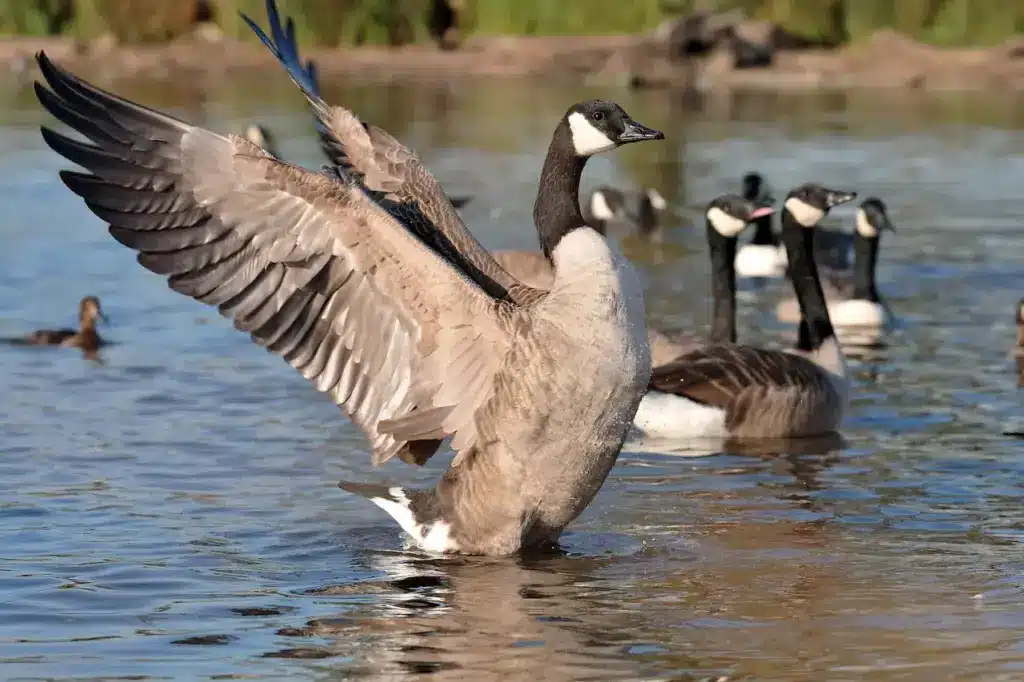
The oldest recorded wild Canada Goose was 30 years and 4 months old. However, the average lifespan in the wild is about 12 years (range between 10 – 25 years). Captive birds can live over 40 years.
Canada Geese have very few natural predators due to their size alone, but eggs and juveniles are at great risk of predation by other birds (crows, ravens, magpies, seagulls), arctic foxes, skunks, raccoons, coyotes, red foxes, minks, bears, dogs and snapping turtles..
Adults are most often injured or killed by human hunters.
The average mortality rate of Canada Geese ranges from 20 – 52%; with male Canada Geese usually suffering higher mortality than females. The survival rate for first-year resident geese ranges between 70 to 90%, and the survival rate for first-year migratory birds ranges between 25 to 80% (with an average of 59%).
Diseases / Health Problems
Common diseases of the Canada Geese include avian cholera, avian botulism, avian salmonellosis, chlamydiosis, duck plague (or duck virus enteritis, DVE), aspergillosis and gizzard worms.
The spread of disease is facilitated in resident (non-migratory) goose populations or large congregations of birds where these geese come in close contact with each other
Many succumb from heavy metal poisoning – picked up from contaminated mining sites, but also caused by the ingestion of lead shots during the hunting season and lead fishing weights).
Diet / Feeding:
Canada Geese are mostly herbivores – feeding on green vegetation (including a variety of grasses, pondweed, clover, cattails, bulrushes and algae), grains and berries (if available) found in shallows, marshes and fields.
Sometimes they will also eat small insects, fish, small crustaceans and molluscs that are attached to aquatic vegetation – particularly when breeding or feeding young, as they need more protein in their diet for their development.
On land, they graze while walking, grasping a plant with its bill and tearing it with a jerk of the head. They will take grains, such as wheat, beans, rice and corn. They will typically eat those plants just as they first emerge after planting, and again when the seed head matures.
In water, they feed on submerged aquatic vegetation (such as seaweeds) by reaching under the water with their long necks or by upending (feeding upside down in water).
In urban cities, they will accept food they are offered by humans or pick food out of garbage bins.
They typically feed in the early morning and late afternoon. When migrating, they may also feed at night.
Food moves fast through its digestive system – sometimes in an hour or even quicker. Therefore, these geese have to take in a lot of food to get the needed nutrition and produce large amounts of feces (Elvecrog).
Feeding Ducks and Geese …
We all enjoy waterfowl and many of us offer them food to encourage them to come over and stay around – and it works! Who doesn’t like an easy meal!
However, the foods that we traditionally feed them at local ponds are utterly unsuitable for them and are likely to cause health problems down the road. Also, there may be local laws against feeding this species of bird – so it’s best to check on that rather than facing consequences at a later stage.
- Foods that can be fed to Ducks, Geese and Swans to survive cold winters and remain healthy when food is scarce in their environment.
Please note that feeding ducks and geese makes them dependent on humans for food, which can result in starvation and possibly death when those feedings stop. If you decide to feed them, please limit the quantity to make sure that they maintain their natural ability to forage for food themselves – providing, of course, that natural food sources are available.
Species Research by Sibylle Johnson
Please Note: The articles or images on this page are the sole property of the authors or photographers. Please contact them directly with respect to any copyright or licensing questions. Thank you.

